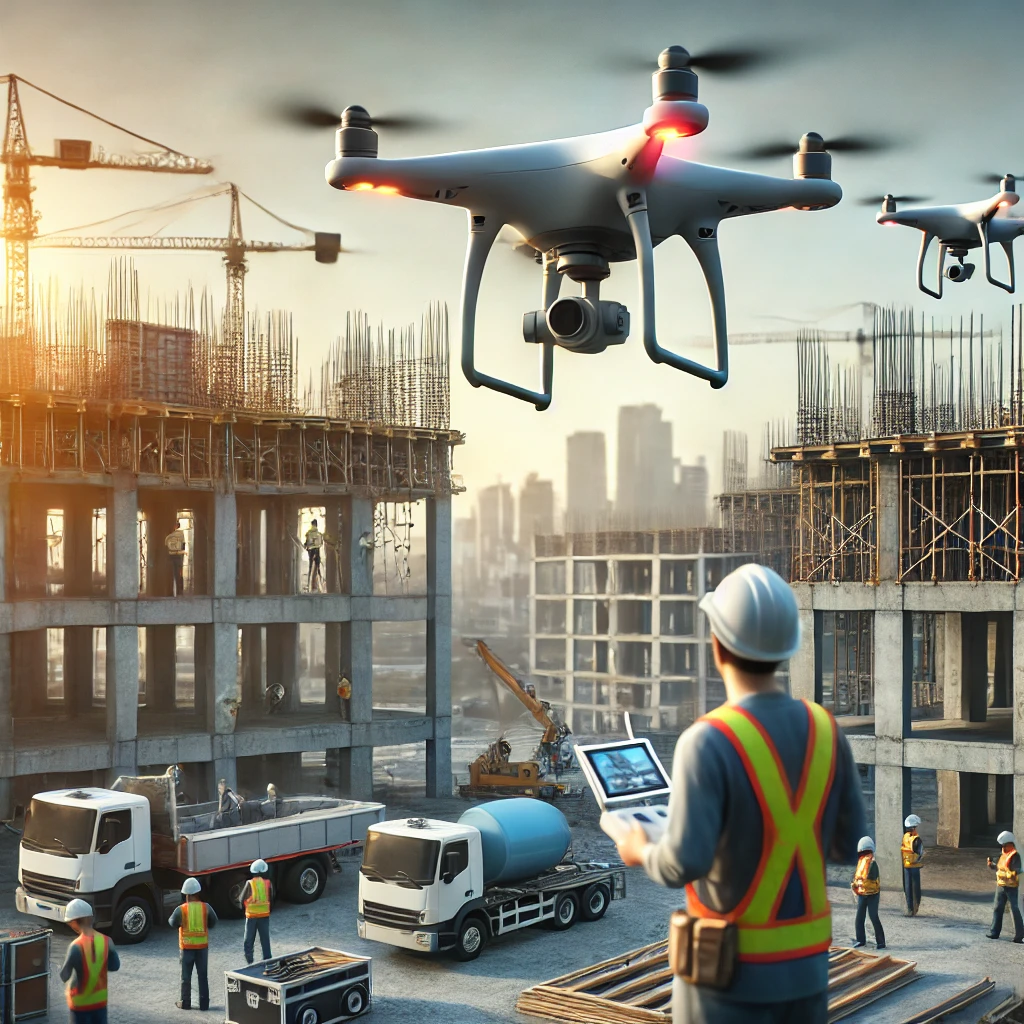Over the last decade, drones have evolved from simple toys to sophisticated tools with applications in various fields such as agriculture, surveillance, photography, and package delivery. With this evolution, there has been a growing demand for skills in drone programming. Learning to program drones not only allows you to customize their operation but also to automate tasks and perform complex maneuvers that go beyond simple manual control. In this guide, we will explore everything from the fundamentals to advanced applications in drone programming, so you can start or enhance your skills in this fascinating field.
Drone Programming Fundamentals
To start programming drones, it’s essential to have a basic understanding of their components and how they interact with each other. While each drone model may have its peculiarities, most share the same fundamental elements.
1. Key Drone Components
- Flight Controller: The flight controller is the drone’s core, acting as the central processing unit (CPU). This device processes the signals received from the sensors and translates programming commands into physical actions, such as adjusting motor speeds or changing flight direction.
- Sensors: Drones are equipped with various sensors that allow them to perceive their environment. These include accelerometers, gyroscopes, barometers, and magnetometers. These sensors are crucial for maintaining the drone’s stability and enabling precise navigation.
- Motors and Propellers: The motors, along with the propellers, are responsible for generating the lift and thrust necessary for the drone to fly. Programming can adjust motor speeds to control the drone’s altitude, direction, and speed.
- Battery: Provides the necessary power for all the drone’s components to function. Efficient battery management is crucial for maximizing flight time and ensuring the drone can complete its programmed missions.
2. Programming Environment
Drone programming requires an appropriate development environment, which includes both specific software and hardware. Below, we explore the key elements of the programming environment:
- Programming Languages: Drones can be programmed using various languages, with Python and C++ being the most common. Python is appreciated for its simplicity and ease of learning, while C++ is preferred for its efficiency and more granular control over hardware. Other languages like JavaScript and MATLAB are also used in certain drone programming applications.
- Operating Systems for Drones: Operating systems such as ROS (Robot Operating System) and PX4 are popular in drone software development. ROS offers a flexible platform for creating complex robotic applications, while PX4 is a specialized autopilot operating system widely used in the drone industry.
- Tools and Libraries: Various tools and libraries make drone programming easier. For example, DroneKit is a Python API that simplifies the development of applications for ArduPilot-based drones, while MAVLink is a communication protocol used to exchange information between the drone and the flight controller.
Basic Steps to Program a Drone
If you’re new to drone programming, following a structured approach will help you acquire the necessary skills effectively. Here’s a step-by-step guide to get you started:
1. Setting Up the Development Environment
Before you start coding, you need to install the necessary software on your computer:
- Choosing an IDE: An Integrated Development Environment (IDE) will facilitate writing, debugging, and executing code. For Python, PyCharm is an excellent choice, while Visual Studio Code is ideal if you prefer to program in C++.
- Installing Libraries: Depending on the language you choose, you’ll need to install the appropriate libraries. For example, if you’re using Python, you’ll need to install DroneKit via pip (
pip install dronekit). For C++, you may need to set up MAVLink and other dependencies.
2. Connecting the Drone to the Computer
- Via USB or Wireless Connection: Connect your drone to the computer using a USB cable or wirelessly via Wi-Fi or Bluetooth. Ensure that the flight controller is properly configured to accept commands from the computer.
- Initial Drone Configuration: Once connected, you’ll need to configure basic parameters such as sensor calibration, motor setup, and flight limits (maximum altitude, distance from the origin, etc.).
3. Writing and Running Your First Script
The next step is to write a simple script that allows you to control the drone. Here’s a basic example in Python using DroneKit:
from dronekit import connect, VehicleMode
# Connect to the drone
vehicle = connect('/dev/ttyUSB0', wait_ready=True)
# Arm the drone (make it ready to fly)
vehicle.mode = VehicleMode("GUIDED")
vehicle.armed = True
# Wait until the drone is armed
while not vehicle.armed:
print("Waiting for the drone to arm...")
time.sleep(1)
# Take off
vehicle.simple_takeoff(10) # Take off to 10 meters altitude
# Close the connection
vehicle.close()This basic script connects your drone to the computer, arms it, and takes off to an altitude of 10 meters. It’s an excellent starting point for understanding how to send basic commands to the drone.
Advanced Applications in Drone Programming
As you advance in your programming skills, you’ll be able to explore more advanced applications that maximize the capabilities of drones. Some of the most common and useful applications include:
1. 3D Mapping and Cartography
One of the most advanced uses of drones is creating detailed 3D maps of terrains. For this, drones can be equipped with high-resolution cameras and LIDAR sensors. These devices allow the drone to capture a large amount of data, which is then processed to generate precise 3D models.
- Mission Flight Programming: It’s possible to program the drone to follow a specific route covering a wide area, capturing images at regular intervals. This is achieved by writing scripts that control the drone’s movement, ensuring it maintains a constant altitude and adequate overlap between the captured images.
- Data Processing: Once the drone has completed its mission, the data must be processed using specialized software like Pix4D or Agisoft Metashape, which converts the images into 3D maps and topographic models.
2. Autonomous Object Tracking
Drones can be programmed to autonomously follow people, vehicles, or any moving object. This is particularly useful in surveillance, filming, and wildlife monitoring applications.
- Real-Time Detection and Tracking: Using computer vision algorithms, the drone can be programmed to identify and follow objects in real-time. OpenCV is a popular library used in Python to implement this functionality. The drone analyzes the images captured in real-time to adjust its position and keep the object in the center of the frame.
- GPS Integration: In addition to computer vision, tracking functionality can be integrated with GPS data to improve accuracy. For example, if a vehicle is being followed, the drone can use the vehicle’s GPS coordinates to anticipate its movement and adjust its trajectory accordingly.
3. Autonomous Package Delivery
One of the most promising commercial applications for drones is autonomous package delivery. Companies like Amazon and Google are experimenting with this technology, and you can also program a drone to perform automated deliveries.
- Delivery Route Programming: The first stage of programming for autonomous deliveries is defining flight routes. This includes programming delivery points, obstacle avoidance, and planning the most efficient route. DroneKit’s API allows you to program routes using GPS coordinates and adjust altitude and speed based on the terrain.
- Payload Management: A critical aspect is ensuring that the drone can safely handle the payload. This includes programming release mechanisms to drop the package at the destination without damaging the payload. It’s also essential to program checks on the payload’s status during flight, ensuring the package remains stable and secure throughout the mission.
- Regulation and Safety: In many countries, drone package delivery is subject to strict regulations. Part of the drone’s programming includes incorporating safety measures, such as the ability to abort the mission if problems are detected, automatic return to the origin point in case of low battery or signal loss, and compliance with flight restrictions in urban areas or near airports.
Additional Resources for Learning to Program Drones
Drone programming is a constantly evolving field, and staying updated is key to developing advanced skills. Here are some additional resources that can help you expand your knowledge:
1. Online Courses and Tutorials
- Udemy and Coursera offer specialized courses in drone programming, ranging from the basics to advanced applications like autonomous flight programming and image processing.
- YouTube is another excellent source of free tutorials, where you can find everything from basic setup guides to complete drone programming projects.
2. Documentation and Software Communities
- DroneKit Documentation: The official DroneKit documentation is a valuable resource for understanding how to use the API and learn how to write custom scripts for drones.
- PX4 Devguide: If you’re interested in using PX4, their developer guide offers detailed instructions on how to set up and program drones with this operating system.
- Forums and Communities: Participating in communities like DIY Drones, ArduPilot Forum, and ROS Discourse allows you to interact with other programmers and drone enthusiasts, share knowledge, and get help solving specific problems.
3. Books and Publications
- “Programming Drones: The Complete Guide”: This book provides a comprehensive view of drone programming, covering everything from basic concepts to advanced projects.
- “ROS Robotics Projects”: This book is ideal for those looking to integrate drones into broader robotics projects using ROS.
Challenges and Considerations in Drone Programming
While drone programming offers numerous opportunities, it also presents certain challenges that you should consider:
1. Hardware Limitations
Most commercial drones have limitations in terms of processing power, battery capacity, and payload. These limitations can restrict the complexity of the tasks you can program. For example, smaller drones may not be able to handle high-resolution cameras or LIDAR sensors, limiting advanced applications like 3D mapping.
2. Legal Regulations
As mentioned earlier, drone operations are regulated in many countries. It’s important to be aware of local laws that may affect your projects. For example, in some places, autonomous flights are prohibited or require special permits. Additionally, flying drones in populated areas or near airports is often highly restricted.
3. Safety and Reliability
Programming drones for autonomous flights involves great responsibility. It’s crucial to implement redundancies and safety systems in the code to handle unexpected failures, such as signal loss or sensor issues. You should also conduct exhaustive testing in controlled environments before deploying the drone on critical missions.
4. Interoperability
Drone programming often requires integration with other systems, such as communication networks, cloud servers, and databases for processing and storing data. Ensuring that your code is interoperable and compatible with other technologies is fundamental to the success of more complex projects.
Conclusion
Drone programming is a powerful skill that combines knowledge in robotics, programming, and computer vision. Whether you’re interested in flight automation, creating advanced applications like 3D mapping, or autonomous package delivery, the possibilities are nearly endless. With the right resources, constant practice, and a focus on safety and regulations, you can take your drone projects to the next level. Start exploring and creating with drones today!

